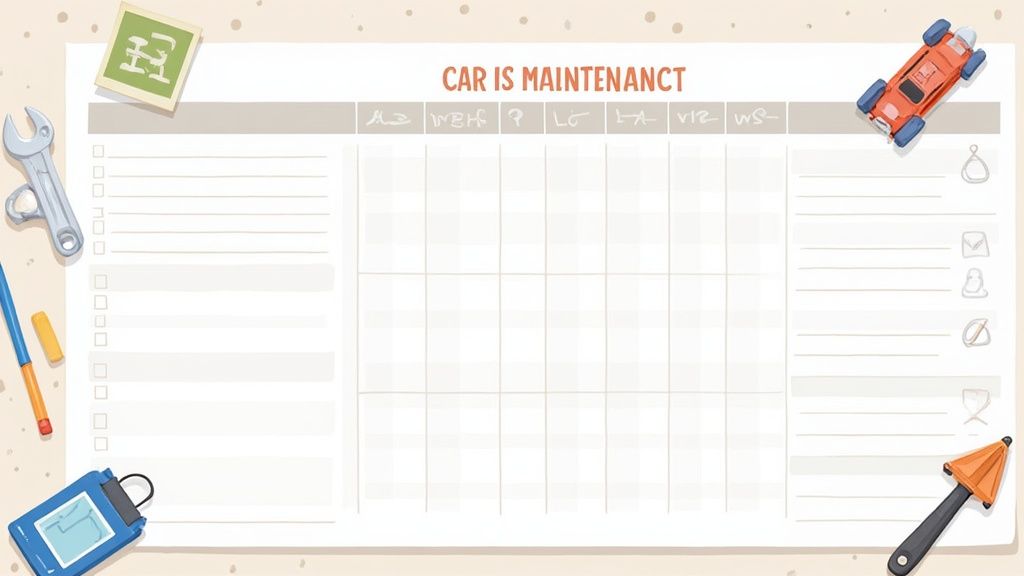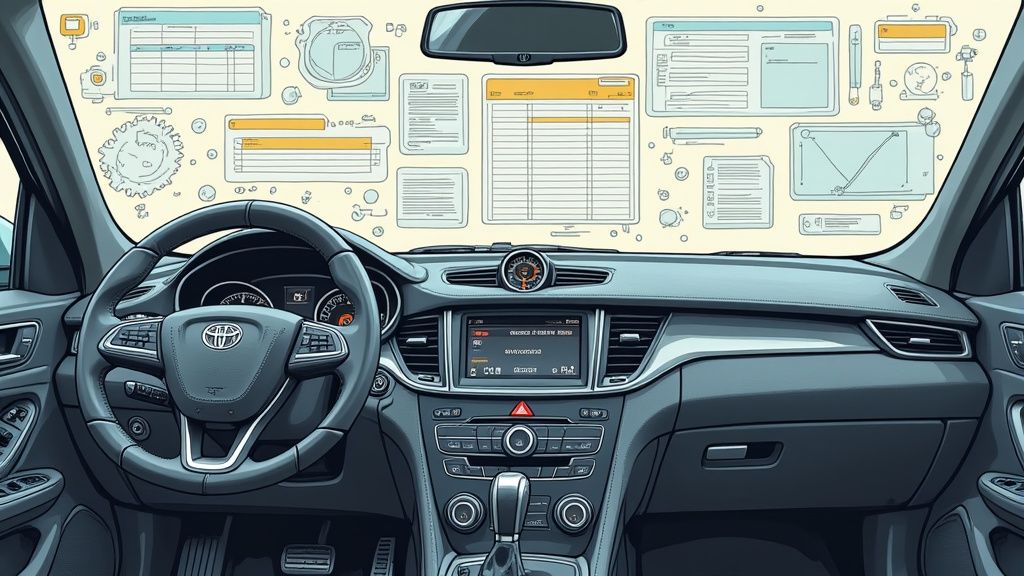
Free Car Maintenance Log Template: Your Expert Guide to Vehicle Care Success
The Real Impact of Strategic Vehicle Tracking

A detailed car maintenance log does much more than document basic repairs - it provides crucial insights that directly affect your vehicle’s performance and your finances. Just as a medical history tracks your health over time, a maintenance log creates a complete picture of your car’s condition and needs. According to AAA studies, proper maintenance tracking can add up to 50,000 miles to your vehicle’s lifespan.
Predictive Power: Preventing Problems Before They Start
Consistent maintenance logging helps you spot emerging issues early. For instance, if your records show frequent brake pad replacements, this pattern may point to underlying problems with the brake system that need attention. By catching these warning signs early, you can fix small issues before they become expensive repairs. Your detailed records also give mechanics the context they need to diagnose problems accurately and efficiently, leading to more targeted and effective repairs.
Resale Value: Demonstrating Diligent Care
A thorough maintenance history significantly increases your car’s resale value. When selling your vehicle, detailed service records prove you’ve taken good care of it over time. Think of it like providing a complete medical history - buyers feel more confident paying top dollar when they can see documented evidence of regular maintenance and repairs. This documentation helps your vehicle stand out in the used car market.
Data-Driven Decisions: Empowering Smart Ownership
Tracking maintenance transforms you from a passive owner into an informed manager of your vehicle’s health. By monitoring fuel efficiency trends, repair frequencies, and other key metrics, you gain insights that guide smarter decisions about driving habits and maintenance timing. For example, tracking a gradual decrease in gas mileage could reveal fuel system problems that need attention. This data-focused approach helps you avoid surprise breakdowns and get the most value from your vehicle. Your detailed records also give you leverage when discussing repairs or warranty claims since you can show your maintenance history. Regular logging puts you in control of your car’s performance, longevity and overall value.
Building Your Perfect Maintenance Template
A car maintenance log template is more than just a simple record - it’s an essential tool for actively managing your vehicle’s health and longevity. Creating an effective template requires thoughtful organization to track both quick daily checks and detailed repair records. Let’s explore how to build a template that serves your specific needs.
Essential Components of a Car Maintenance Log Template

A well-designed maintenance log needs specific sections to organize different types of information, making it easy to record and retrieve important details:
-
Vehicle Identification: Start with the basics - record your vehicle’s make, model, year, VIN, and license plate number. This information is critical for accurate record-keeping, especially if you maintain multiple vehicles.
-
Service Tracking: This forms the core of your template. Include spaces for service date, current mileage, type of service performed (like oil changes or tire rotations), and service provider name.
-
Cost Recording: Track expenses in a dedicated section. This helps monitor spending patterns and identify frequent repairs. These records also come in handy during tax season.
-
Description and Notes: Leave room for detailed entries about work performed, parts replaced, and mechanic recommendations. Good notes provide valuable context for future reference.
-
Reminders: Include a system to track upcoming maintenance. Whether using a digital calendar or dedicated reminder section, this helps prevent missing important service intervals.
Structuring Your Template for Different Needs
Your maintenance log should match your specific vehicle type and how you use it. Here’s how to organize different tracking needs:
-
Basic Maintenance: For routine services, a simple table with date, mileage, service type, and cost columns works well.
-
Detailed Repair Tracking: Complex repairs need extra details like parts replaced, labor costs, and warranty information. This level of documentation helps with warranty claims and tracking recurring issues.
-
Fuel Efficiency Monitoring: If tracking fuel economy matters to you, add a section for fuel consumption and mileage. This data helps spot potential issues early.
For example, a delivery driver needs detailed tracking of fuel use and tire wear, while someone using their car mainly for commuting might focus on basic maintenance records. Classic car owners often need specialized sections for tracking rare parts and modifications.
Creating the right template is like choosing the right tools - it should fit your specific needs while making record-keeping straightforward. Good records contribute directly to better vehicle maintenance, improved performance, and stronger resale value.
Choosing Between Digital and Traditional Systems

Once you understand the core components of a car maintenance log template, you’ll need to decide whether to use a paper-based or digital system to track your vehicle’s maintenance. Both approaches offer distinct benefits and limitations that are worth considering carefully. Let’s examine the key aspects of each option to help you choose the system that best fits your needs and habits.
Traditional Paper-Based Systems: Simplicity and Tangibility
Many car owners prefer the straightforward approach of a physical maintenance logbook or binder. The main appeal lies in its simplicity - you just need a pen and paper to record service details, with no technical requirements or learning curve. Having a physical book makes it easy to quickly browse through past maintenance records and jot down notes during service visits. But paper logs do have clear drawbacks. They can get lost, damaged by water or oil, or become messy over time. Finding specific maintenance records can also be time-consuming when flipping through numerous pages of handwritten entries.
Digital Systems: Power and Accessibility
Digital maintenance tracking through tools like AUTOsist or Auto Service Logger offers significant advantages. These systems make it simple to input data, automatically calculate service intervals, and store records securely in the cloud - meaning you can access your maintenance history from any device. Many apps include helpful features like maintenance reminder notifications and expense tracking reports to identify potential cost savings. The main challenges are that digital tools require some tech familiarity to set up and use effectively. You also need reliable device and internet access to maintain digital records consistently.
Hybrid Solutions: Combining the Best of Both Worlds
Many vehicle owners find that using both digital and paper systems provides an ideal balance. For example, you might track most maintenance digitally while keeping a basic paper log in your glove box for quick reference. You can also print key reports from your digital system to maintain physical backup copies. This flexible approach lets you use digital tools for comprehensive record-keeping while having paper records on hand when needed. You might track oil changes and major services digitally but log daily mileage and fuel fill-ups in a small notebook. The key is creating a system that you’ll actually maintain long-term, whether that’s fully digital, traditional paper, or a practical combination of both methods.
Customizing Logs for Different Vehicle Needs

When it comes to tracking vehicle maintenance, one size does not fit all. A basic maintenance log works well for simple needs, but different vehicles serve different purposes - from daily commuter cars to commercial delivery trucks putting on thousands of miles each week. Each requires its own specific approach to maintenance tracking. Let’s explore how to adapt maintenance logs for various vehicle types and usage patterns.
Performance Metrics and Modifications: Going Beyond the Basics
Car enthusiasts and owners of modified vehicles need more detailed records than standard maintenance logs provide. They benefit from tracking performance data like acceleration times, braking distances, and fuel economy changes after installing upgrades. Keeping thorough records of modifications, including part specifications, installation dates, and costs, helps diagnose issues and adds value when selling. For instance, having documentation that proves quality parts were properly installed makes a modified vehicle more appealing to potential buyers.
Managing Multiple Vehicles: Streamlining Fleet Tracking
For families and small businesses with multiple vehicles, keeping separate maintenance logs quickly becomes messy and inefficient. A better approach is creating one master template that works across different vehicle types. This allows you to maintain consistent records while tracking each vehicle’s unique needs. Features like individual vehicle profiles make it simple to view service histories, monitor maintenance costs, and spot patterns across your fleet.
Specialized Templates: Addressing Unique Vehicle Types
Some vehicles demand more specific documentation than others. Classic car owners, for example, need to track rare replacement parts, restoration work, and historical changes to maintain their vehicle’s value and authenticity. Commercial vehicles require detailed monitoring of fuel usage, tire wear patterns, and cargo capacity to optimize operations and control costs. These specialized logs help fleet managers make data-driven decisions about routes, driver performance, and vehicle longevity.
Combining Tracking Systems: Creating a Master Template
Many vehicle owners find that using both digital and paper records works best for their needs. Digital logs offer easy searching and backup copies, while paper logs provide quick reference during service visits. For example, keep comprehensive digital records at home but store a basic printed log in each vehicle for recording oil changes and tire rotations. This hybrid approach ensures you always have access to maintenance records, whether you’re at a computer or under the hood. By thoughtfully combining different tracking methods, you can build a system that helps you better maintain your vehicles and make smarter long-term decisions about their care.
Turning Records into Valuable Insights
A detailed car maintenance log template does more than just track basic data—it provides key information that helps you save money, extend your vehicle’s life, and make smart maintenance decisions. Similar to how doctors examine patient records to diagnose health issues, your maintenance records tell an important story about your vehicle’s condition.
Finding Patterns and Planning Ahead
Over time, a well-kept maintenance log reveals meaningful patterns about your vehicle. For example, if your records show multiple battery replacements within a few years, this could point to an underlying charging system problem rather than just faulty batteries. By spotting these trends early, you can address root causes before they lead to bigger issues—potentially saving hundreds in unnecessary repairs. Just as medical histories help doctors identify chronic conditions, your maintenance records highlight recurring problems.
Fine-Tuning Service Schedules
Your maintenance log helps determine the optimal service timing for your specific vehicle. Consider oil changes—if you’re changing oil every 3,000 miles but your manufacturer recommends 5,000-mile intervals, you may be servicing too frequently. By aligning your schedule with manufacturer guidelines and your car’s actual needs, you can maintain reliability while avoiding unnecessary maintenance costs.
Documentation for Repairs and Warranties
A detailed maintenance log becomes especially valuable when dealing with repair shops and warranty claims. Having complete service records provides proof of proper maintenance and strengthens your position when seeking warranty coverage. For instance, if a covered part fails and your log shows you followed the recommended service schedule, you’ll have clear documentation to support your claim. Think of it like having detailed receipts when returning a defective product—proper records protect your interests.
Better Resale Value Through Documentation
When it’s time to sell your vehicle, thorough maintenance records are a major asset. Potential buyers gain confidence seeing documented proof of regular care and service. This detailed history often leads to faster sales at better prices since buyers are willing to pay more for well-maintained vehicles with clear service records. Just as certified pre-owned programs add value through documentation, your maintenance log demonstrates responsible ownership. Remember, maintaining detailed records isn’t just about tracking service—it’s about creating a valuable tool that saves money and improves your entire vehicle ownership experience through smart analysis, proper scheduling, and stronger negotiating power.
Implementation Strategies That Actually Work
A car maintenance log is only as good as how consistently you use it. Success comes from putting practical systems in place for record keeping, managing documentation, and regular review. When done right, your maintenance log becomes an essential tool for extending your vehicle’s life and preventing costly repairs.
Establishing a Routine That Sticks
The key to maintaining good records is making it a natural part of your regular car care habits. For instance, you might set aside time each month when you pay your car insurance to update your maintenance log and plan upcoming service. Another approach is linking log updates to regular activities like refueling - each time you fill up, record the mileage and fuel data. When logging becomes automatic, you’re more likely to keep it up long-term.
Digital Backup and Receipt Management
For digital logs, having secure backups is essential. Cloud storage provides automatic syncing and version history to protect your records. Consider scanning or photographing paper receipts to store digitally with your log entries. This creates a complete record that’s easily accessible when needed for warranty claims or taxes. For example, AUTOsist lets you upload receipt photos directly in the app and link them to specific services, eliminating paper files while tracking costs for each maintenance task.
Regular Review and Analysis
Taking time to review your maintenance records helps identify patterns and catch potential problems early. Set a reminder to analyze your log every few months. Look for signs like repeated repairs of the same part, which could point to underlying issues. Tracking fuel efficiency over time can reveal developing engine problems. These insights let you address concerns proactively before they become major repairs.
Troubleshooting Common Challenges
Even with good intentions, keeping up with maintenance records can be challenging. If you often forget to log services, try setting phone reminders or putting a note on your dashboard. For receipt management, designate a specific spot to collect receipts until you can record them. When multiple people maintain the same vehicle, assign clear responsibilities so everyone knows their role in keeping accurate records.
Maintaining detailed service records is one of the best investments you can make in your vehicle’s health and value. By following these practical strategies, you’ll have organized, accessible documentation to guide maintenance decisions and prevent problems. Start logging your car maintenance efficiently and securely with Auto Service Logger – get your lifetime membership today at https://autoservicelogger.com/.